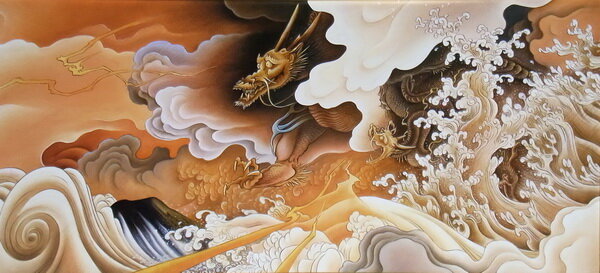Unusual Creatures for Unusual Games!

One of the points we talked about last night on the Unusual Creatures show was that the creatures need to suit the setting. Throwing an allosaurus into a normal fantasy game feels odd, and not the good odd of an Oddity. It just feel kinda wrong, unless there is a reason for the allosaurus being there.
In some genre, and settings, this is easy. Lost World/ Hollow Earth settings beg for dinosaurs. Superhero settings accept them pretty easily, because a lot of the time anything goes in a super setting. Even a Sword & Sorcery setting accepts them well, as holdovers from the distant past, from which tales of dragons and fell monsters have sprung up.
The key is veresimilitude: If the creature fits the setting, players will find it compelling instead of off-putting. In the show comments (and, I think, in the show itself too) people talked about how the various Monster Manuals for iterations fo D&D feel like a messy hodge-podge of creatures, thrown together. Obviously that is exactly what they are, buy design. WotC is not telling you how to use their book, only providing the tools of play.They leave the decisions for versimiltude up to the DM. Fair enough. When you, as DM, choose your monsters, do you pick them because they will provide a string of interesting fights/encounters? Or do you choose htem because they make sense in a story sequence? Or in an environmental one? Depending on the kind of game you are playing, there is no wrong answer. But if you are looking for veresimilitude, you should probably be looking at all three factors. A Lost Island of Dinosaurs makes more sense than deciding that T-rexes are the top predator in a region dominated by mammalian life. Why would tigers and bears compete, or evolve (how could they do either with a t-rex at the top of the food chain). But maye this is a question you want your players to ask, so that they can go after that crazy necrochronomancer who is bringing fossils back to life in a bid for world domination.
So in designing creatures, I suggest that the same mantra be followed. Unless you want a creature to appear as out of place, you need to choose or design monsters with the setting in mind.
Here is an example:
Years ago, when 3rd edition D&D was still fresh, I created a setting that I called the Shards, in which the world had been saved at the point of destruction by the intervention of dozens of gods, who sacrificed themselves to preserve the world. Unfortunately they were to late to prevent the destructive explosion, but they managed to preserve life, and the conditions for life on the thousands of shards. So you have a belt of planetary shards orbiting the sun, in a Void with weather and breathable air, and the potential for travel. Basically, I was trying to make a Spelljammeresque game that made a little more sense (and avoided the giant space-hamsters, which are a really good example of how to break veresimiltude: If you know nothing about Spelljammer, chances are you still have heard about the absurd giant space-hamsters.
In the Shards setting, travel between the shards was possible, and accomplished by voidships, sailing vessels built from parts of the dragons that lived in the Void. A culture of Voidfarers grew up, along with the Dragoneers, essentially whalers who hunted dragons, all to provide parts for voidships - and keep the Void safe by reducing the number of dragons out there.
Naturally, the dragons would be less than thrilled with this. So I created the Shards version of the Leviathan, crossed with the legend of the Flying Dutchman: a dragon skeleship with its own intellect, and an obsessed with collecting the remains of slain dragons to rebuild itself. It was the bugaboo monster of dragoneers especially, but no one who traveled the Void was safe.
I think a necromantic dragonship obsessed with reassembling itself is a pretty unusual concept for a monster. But it fits, and (I think) enriches the setting. I could imagine tales told by grizzled dragoneers in Voidside taverns, of the time they saw the Leviathan, of how they abandoned the half-harvested carcass of the Cerulean Ridgeback they were harvesting, running on the astral wind a single breath a head of the monster.
I could also imagine a place for the leviathan in the "ecology" of the Void. As a necromagical artifact with a specific goal, it did not eat in the normal fashion, so it might actually attract swarms of small creatures that were relatively safe in its rigging, but would benefit from its proximity, even feed off of the scraps. This brought about the notion of abyss ghouls, humanoids who had adapted, or been altered, to fly the Void seeking sustenance wherever it might be found. Abyss ghouls fit the role of remorah to the Leviathan's great white shark.



